Fisher Body Number Plate - 1969
[ Preface ] | [ 1964 ] | [ 1965 ] | [ 1966 ] | [ 1967 ] | [ 1968 ] | [ 1969 ] | [ 1970 ] | [ 1971 ] | [ 1972 ]
[ Atlanta ] | [ Baltimore ] | [ Framingham ] | [ Fremont ] | [ Kansas City ] | [ Oshawa ]
Introduction: For quite some time I’ve had an intense interest in Fisher Body Number plates, a.k.a. trim tag, cowl tag, firewall tag, etc. for 1964 through 1972 Chevelles - hereafter referred to as ‘trim tag’ since that seems to be most common moniker for these little jewels. Their diversity, not only between the different years but between the different plants in a given year, has always fascinated me. This page deals only with 1969 Chevelle trim tags.
The sixth model year of the Chevelle, 1969, saw its final assembly production occur at 5 plants in the U.S. - Atlanta, Georgia - Baltimore, Maryland - Framingham, Massachusetts - Fremont, California - and Kansas City, Missouri - plus Oshawa, Ontario in Canada. The 1969 model year is the last year Framingham and Fremont would assemble Chevelles in this era.
I’ll not attempt to decode what each trim code, paint code, and where applicable, group option codes in this series represent. Click on any year's link in the navigation menu at the top of the page and choose the appropriate link on that year's home page where you’ll find links for detailed information for interior, paint, and group option codes.
All research to date indicates that each Fisher Body plant assigned body numbers in sequential order regardless of Fisher Body style numbers as they did in previous years. However, body numbers did not run sequentially from 000001 through some final production as they tended to do in earlier years. Whatever numbering system was used (and each plant's numbering system was unique to that plant), the reasoning is probably a result of the essential demise of Fisher Body as a separate entity within General Motors in 1968 when they were reorganized into the General Motors Assembly Division (GMAD) and many Fisher Body plant operations were absorbed.
The Fisher Body unit number has nothing to do with the vehicle identification number (VIN) assigned by GM at final assembly and if any were to match, it’d be a coincidence.
With that, let's begin 1969.
The 1969 Fisher Body Number plate for Atlanta contained only basic information and no frills. The Atlanta plant did not build station wagons, convertibles, or 4-door sport sedans in 1969. Atlanta showed no production numbers for May and June of 1969.

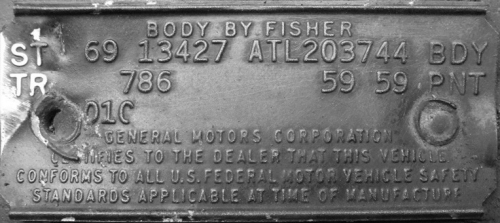
The first information line contains the abbreviation ST (for Style) followed by the model year (69) and the Fisher Body style number. Next is the designation for the plant location, ATL for Atlanta, and the Fisher Body unit number followed by BDY. It should be noted that the Fisher Body style number (13637 for a Malibu sport coupe and 13427 for a 300 Deluxe 2-door pillar coupe in the examples) has nothing to do with the GM VIN series/model designation. That means the 13427 does not indicate a V8 engine just because the third digit is an even number; in fact, this particular 13427 Chevelle is an L6 Chevelle due to its 13327xxxxxxxx VIN. Fisher Body did not care if the car was to receive a V8 or L6 engine. Generally, the Fisher Body unit number, 144626 and 203744 in these cases, was sequential for all body styles and not unique to any single style although it's not known what number was used to begin the sequencing.
There is also a hand stamped number (15 and 11 on these examples) visible on most examples presented here that is believed to be a final inspector’s stamp. This 1- or 2-character hand stamped number has been found in various locations on the trim tag so it won’t always be in the same location as the examples.
The second information line contains the abbreviation TR (for Trim) followed by a 3-digit number indicating the seat type (bucket or bench), color and material. Next is a pair of 2-digit numbers indicating the exterior paint color with the lower body color represented by the first pair and the upper body color represented by the second pair, and finally the word PNT. When the second pair is replaced by a single letter, this single letter indicates a vinyl or convertible top color. The first example, 65 E, means the car has a vinyl top as noted by the letter "E" where the second example has a painted top as noted by the second "59" paint code.

If there are one or two hyphens in the paint code positions it indicates the car was ordered with the special paint option as in the example above of - C. See the paint code page for more information on special order paint.
The third information line only contains the body assembly date consisting of the month as a 2-digit number and a single letter (A…E) designating the week. When the month is a single digit month (January through September) the month number is padded with a leading zero (0) such as 01, 02, 03, etc. In the examples 11A is the 11th month (November) and “A” represents the 1st week and 01C is the 1st month (January) and "C" represents the 3rd week.
It should be noted that the Atlanta plant did not report any production figures for May or June of 1969, although very early May (05B) body dates have been found. Atlanta extended production into late August, at least as late as 08C, where other plants shut down 1969 model year production in late July or very early August.
Baltimore is one of two 1969 assembly plants to change the physical size of their trim tag during the 1969 model year. Sometime between 11B and 11D, the tag changed from previous years' size of 1-3/4"x4" to 2-3/16"x3-1/2".
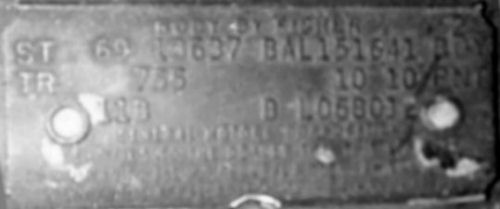
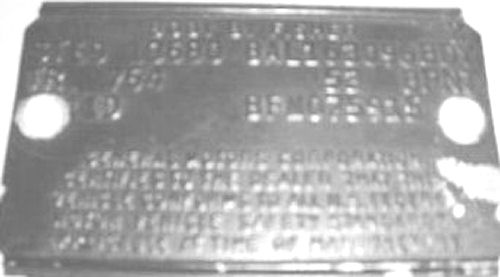
The first information line has a 1- or 2-digit number embossed that is believed to be the body cradle number used for quality control.
The second information line contains the abbreviation ST (for Style) followed by the model year (69) and the Fisher Body style number. Next is the designation for the plant location, BAL for Baltimore, and the Fisher Body unit number followed by BDY. It should be noted that the Fisher Body style number (13637 for a Malibu sport coupe and 13680 for a Malibu sedan pickup) has nothing to do with the GM VIN series/model designation. That means the 13637 does not indicate a V8 engine just because the third digit is an even number. Fisher Body did not care if the car was to receive a V8 or L6 engine. Generally, the Fisher Body unit number, 151541 and 163096 in these cases, was sequential for all body styles and not unique to any single style. The body number is also found as the ID number on the Body Broadcast Copy paperwork.
The third information line contains the abbreviation TR (for Trim) followed by a 3-digit number indicating the seat type (bucket or bench), color and material. Next is a pair of 2-digit numbers indicating the exterior paint color with the lower body color represented by the first pair and the upper body color represented by the second pair, and finally the abbreviated word PNT. When the second pair is replaced by a single letter, this single letter indicates a vinyl or convertible top color. The second example, 52 B, means the car has a vinyl top as noted by the letter "B" where the first example has a painted top as noted by the second "10" paint code.

If there are one or two hyphens in the paint code positions it indicates the car was ordered with the special paint option as in the example above of - -. See the paint code page for more information on special order paint.
The fourth information line contains the body assembly date consisting of the month as a 2-digit number and a single letter (A…E) designating the week. When the month is a single digit month (January through September) the month number is padded with a leading zero (0) such as 01, 02, 03, etc. In the examples 11B is the 11th month (November) and “B” represents the 2nd week and "D" represents the 4th week. Baltimore appears to have been a bit sloppy here in January in the way the date was stamped, particularly the use (or not) of a space between the month and week. There are examples of "1 C," "1D," and "01D."
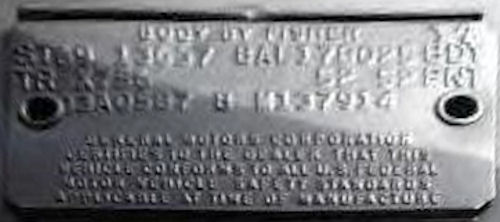
The 4-digit number 0587 is believed to be a Fleet & Special Order tracking code.
Following the body assembly date are some letters (from none to 3) that are under research as to their meanings. The following are only conclusions drawn to date and not backed by any documented facts. These are believed to pertain to either interior or exterior (or maybe both) trim brightwork based on the body style by Fisher.
Probably the most controversial is the letter "L" as to whether or not this letter indicates any SS396 trim and therefore can prove a 1969 Chevelle was ordered with the SS396 option. Again, there is no real proof of this. The letter "B" is consistent with non-convertible bodies.
The letter(s) are listed along with series and body styles
on trim tags I currently have. If you have any 1969 Baltimore Chevelle
trim tags of any series not listed or tags of any series listed but
with different letters, please feel free to contact me with this information
via the Contact link in the navigation
bar.
No letters - 13469 300 Deluxe 4-door sedan
B - 13669 Malibu 4-door sedan
BFL - 13680 Malibu sedan pickup
BFM - 13680 Malibu sedan pickup
B L - 13637 Malibu sport coupe, 13437 300 Deluxe sport coupe
B M - 13637 Malibu sport coupe, 13639 Malibu sport sedan
F - 13427 300 Deluxe coupe
M - 13667 Malibu convertible
Following these letter(s) (or lack of) is a 6-digit number that is actually a concatenation of 2 3-digit numbers. These are data processing tracking numbers and of no real significance today. The first 3 digits have not been correlated to any paperwork to date but the second 3 digits correspond to the trim inspection sequence number found on the trim card. This 6-digit number also appears to be sequential regardless of the body style.
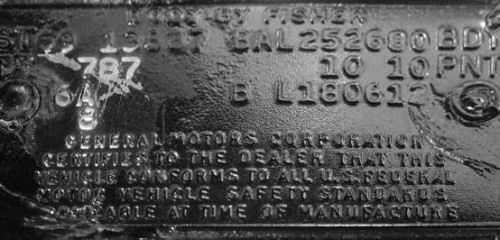
Sometime around 06A a mysterious number "8" began appearing either to the right or just below the body assembly date. The significance of this is not known.
The 1969 Framingham trim tags contained only basic information and no frills.
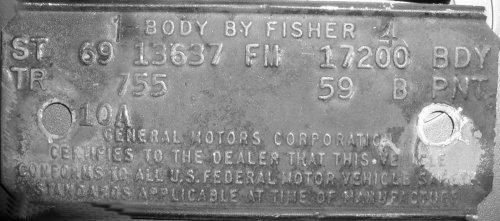
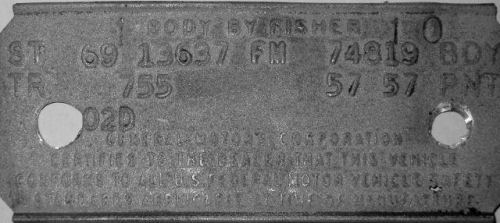

The first information line contains the abbreviation ST (for Style) followed by the model year (69) and the Fisher Body style number. Next is the designation for the plant location, FM for Framingham, and the Fisher Body unit number followed by BDY. It is known that Framingham was not the only plant to use a Fisher Body style number with an odd 3rd digit as Fremont did as well in 1969. That means the 13637 does indicate a V8 engine because the third digit is an even number. An L6 engine in the car would mean a 13567 on the Fisher Body plate. Generally, the Fisher Body unit number, 17200, 74819, and 81688 in these cases, was sequential for all body styles and not unique to any single style. The body number sequence is sequential for all divisions assembled at the plant, not just Chevelles. Buick, Chevrolet, Oldsmobile, and Pontiac all built A-body cars at Framingham in 1969.
There is also hand stamped numbers (1 & 4 and 1 & 10 on two of these examples) that is believed to be final inspector’s stamps. These hand stamped numbers are generally found to the left and to the right of the embossed BODY BY FISHER text on the top of the trim tag but it's possible that one or both could be stamped in another location.
The second information line contains the abbreviation TR (for Trim) followed by a 3-digit number indicating the seat type (bucket or bench), color and material. Next is a pair of 2-digit numbers indicating the exterior paint color with the lower body color represented by the first pair and the upper body color represented by the second pair, and finally the word PNT. When the second pair is replaced by a single letter, this single letter indicates a vinyl or convertible top color. The first example, 59 B, means the car has a vinyl top as noted by the letter "B" where the second example has a painted top as noted by the second "57" paint code.
It's not yet known how Framingham handled coding for special paint.
The third information line only contains the body assembly date consisting of the month as a 2-digit number and a single letter (A…E) designating the week. When the month is a single digit month (January through September) the month number is padded with a leading zero (0) such as 01, 02, 03, etc. In the examples 10A is the 10th month (October) and “A” represents the 1st week and 02D is the 2nd month (February) and "D" represents the 4th week.

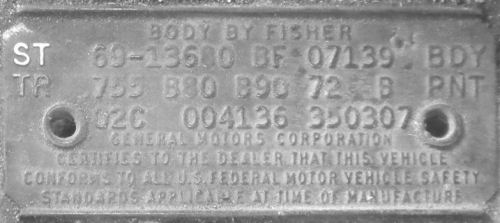
The first information line contains the abbreviation ST (for Style) followed by the model year (69), a hyphen, and the Fisher Body style number. Next is the designation for the plant location, BF for Fremont, and the Fisher Body unit number followed by BDY. It is known that Fremont was not the only plant to use a Fisher Body style number with an odd 3rd digit as Framingham did as well in 1969. Generally, the Fisher Body unit number, 20954 and 07139 in these cases, was sequential for all body styles and not unique to any single style but Fremont does appear to number bodies sequentially by style number. The body number sequence is known to not have begun with 000001 at Fremont as Fremont assembled 68,119 Chevelles in 1969 and no Fremont body numbers go anywhere near this high. It's not known if other divisions assembled models here (as was done at Framingham) which might account for body unit numbers much higher than the Chevelle count. Fremont is the only plant to use body numbers sequential by particular style.
There is also a hand stamped number (6 and 2 on these examples) that is believed to be a final inspector’s stamp. This 1- or 2-character hand stamped number has been found in various locations on the trim tag so it won’t always be in the same location as the examples. Due to the locations found on the first example, there may have been more than one inspection.
The second information line contains the abbreviation TR (for Trim) followed by a 3-digit number indicating the seat type (bucket or bench), color and material. Next is the RPO code B80 (Roof Drip Molding) or the RPO codes B80 and B90 (Door Window Frame Molding) on the El Camino. I currently only have examples of Malibu sport coupes and Malibu sedan pickup trim tags so it's uncertain if these codes appear on other series or body styles.
Next is a pair of 2-digit numbers indicating the exterior paint color with the lower body color represented by the first pair and the upper body color represented by the second pair, and finally the word PNT. When the second pair is replaced by a single letter, this single letter indicates a vinyl or convertible top color. The second example, 72 B, means the car has a vinyl top as noted by the letter "B" where the first example has a painted top as noted by the second "76" paint code.
It's been reported that Fremont also used a hyphen character to signify special paint but, to date, no Fremont trim tag with special paint has been located.
The third information line only contains the body assembly date consisting of the month as a 2-digit number and a single letter (A…E) designating the week. When the month is a single digit month (January through September) the month number is padded with a leading zero (0) such as 01, 02, 03, etc. In the examples 04A is the 4th month (April) and “A” represents the 1st week and 02C is the 2nd month (February) and "C" represents the 3rd week.
Following the body assembly date code are 2 pair of 6-digit numbers. These are data processing numbers also found on the build sheet in two of the boxes and have no real significance today. The 1st 6-digit number is found in block 24, the 2nd 6-digit number is actually a concatenation of a 2-digit number found in block 10 and a 4-digit number found in block 24. If one is lucky enough to find a build sheet, these numbers will help in the matching of the build sheet to the car itself.
Kansas City is one of two 1969 assembly plants to change the physical size of their trim tag during the 1969 model year. Sometime between 11B and 11D, the tag changed from previous years size of 1-3/4"x4" to 2-3/16"x3-1/2".
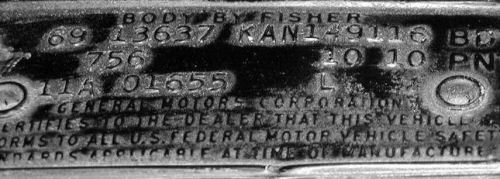
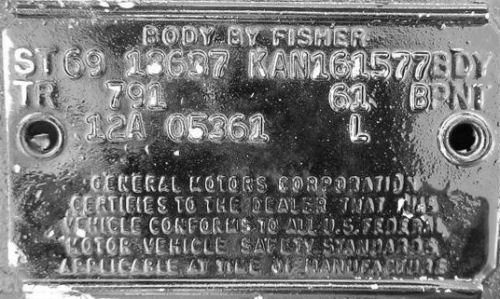
The first information line contains the abbreviation ST (for Style) followed by the model year (69) and the Fisher Body style number. Next is the designation for the plant location, KAN for Kansas City, and the Fisher Body unit number followed by BDY. It should be noted that the Fisher Body style number (13637 for a Malibu sport coupe in the examples) has nothing to do with the GM VIN series/model designation. That means the 13637 does not indicate a V8 engine just because the third digit is an even number. Fisher Body did not care if the car was to receive a V8 or L6 engine. Generally, the Fisher Body unit number, 149116 and 161577 in these cases, were not sequential for a particular body style as many body numbers for various styles have been found out of sequence with body assembly dates for the same style number.
The second information line contains the abbreviation TR (for Trim) followed by a 3-digit number indicating the seat type (bucket or bench), color and material. Next is a pair of 2-digit numbers indicating the exterior paint color with the lower body color represented by the first pair and the upper body color represented by the second pair, and finally the word PNT. When the second pair is replaced by a single letter, this single letter indicates a vinyl or convertible top color. The first example, 10 10, means the car has a painted top as noted by the second "10" paint code where second example has a vinyl top as noted by the letter "B."

If there are one or two hyphens in the paint code positions it indicates the car was ordered with the special paint option as in the example above of - -. See the paint code page for more information on special order paint.
The third information line only contains the body assembly date consisting of the month as a 2-digit number and a single letter (A…E) designating the week. When the month is a single digit month (January through September) the month number is padded with a leading zero (0) such as 01, 02, 03, etc. In the examples 11A is the 11th month (November) and “A” represents the 1st week and 12A is the 12nth month (December).
Next is a 5-digit number that is purported to decode to the xxxxth car on the x work day of the week. Example of 05361 would decode to the 536th car on the 1st work day of the week. Whether this is true or not is open to debate.
Next there may be 1 or 2 letters embossed on the tag that is believed to pertain to either interior or exterior (or maybe both) trim brightwork based on the body style by Fisher.
Probably the most controversial is the letter "L" as to whether or not this letter indicates any SS396 trim and therefore can prove a 1969 Chevelle was ordered with the SS396 option. At least one verified SS-optioned Malibu sport coupe has been found without this letter "L" and another known to not be an SS has this letter. Again, there is no real proof one way or the other.
The letter(s) are listed along with series and body styles on trim
tags I currently have. If you have any 1969 Baltimore Chevelle trim
tags of any series not listed or tags of any series listed but with
different letters, please feel free to contact me with this information
via the Contact link in the navigation
bar.
No letters - 13637 Malibu sport coupe, 13680 Malibu sedan pickup
L - 13637 Malibu sport coupe, 13667 Malibu convertible, 13680 Malibu
sedan pickup
T W - 13639 Malibu sport sedan
X - 13427 300 Deluxe coupe
X L - 13427 300 Deluxe coupe
XZ - 13236 Nomad 4-door wagon, 13427 300 Deluxe coupe, 13480 300 Deluxe
sedan pickup
Z - 13437 300 Deluxe sport coupe
AVO is thought to be an abbreviation for "Avoid Verbal Orders" or some similar acronym to show some deviation from normal production (like special paint) and the 205 is the order number itself. This order number was sequential but used on any GM vehicle that had some sort of special order attached to it meaning any Buick, Olds, Pontiac, etc. could have AVO 204 or AVO 206 for example.
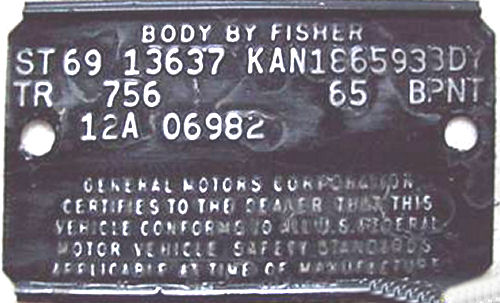
No letters

Single "L"
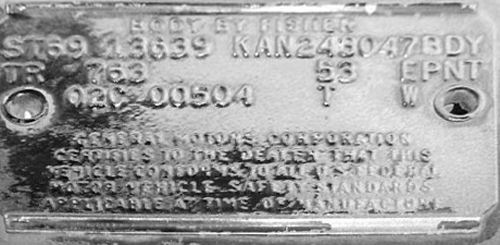
"T" and "W"

"X"

"X" and "L"
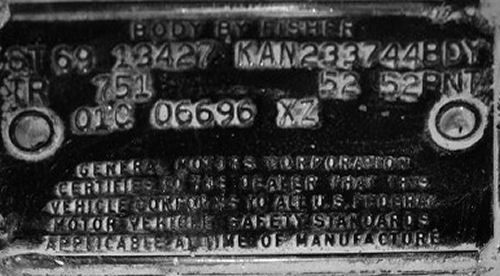
"XZ"

"Z"
Kudos to Andy Martin for his extensive research on 1969 Chevelle Fisher Body Number plants for providing much appreciated insight to information presented on this page.
The Oshawa, Ontario plant Style number does indicate whether the
car was to have an L6 or V8 engine. The 1969 model year saw another
change in the layout of the trim tag. The physical size remained and
MADE IN CANADA remained on the top portion of the tag but the lower
portion of the tag changed to:
BODY BY FISHER
GENERAL MOTORS CERTIFIES TO THE DEALER THAT
THIS VEHICLE CONFORMS TO ALL U.S. GENERAL
MOTORS VEHICLE SAFETY STANDARDS APPLICABLE AT
TIME OF MANUFACTURE
except for Chevelles that were due for export outside U.S. or Canada.
Since they did not have to conform to U.S. standards those trim tags
only had BODY BY FISHER on the top portion.
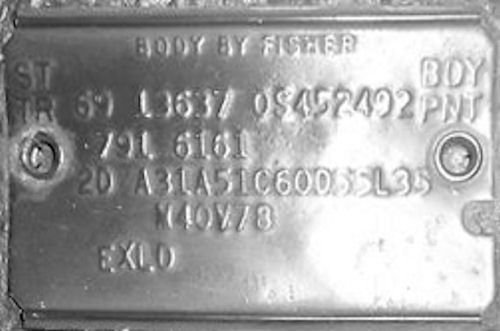
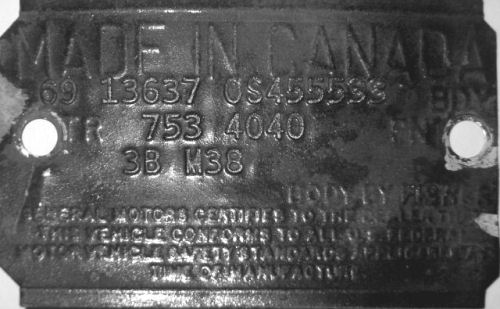
The 1969 model year trim tag also brought the format more in line with the U.S. tag.
The first information line contains the abbreviation ST (for Style) followed by the model year (69) and the Fisher Body style number. Next is the designation for the plant location, OS for Oshawa, and the Fisher Body unit number followed by BDY. As Oshawa did code L6 body style numbers on their trim tags, the two 13637 styles above would indicate they are V8 Chevelles. The example below with style number 13327 would indicate it is an L6 Chevelle. It's believed the body number is sequential regardless of the style. It is not known at this time what the starting number might have been.
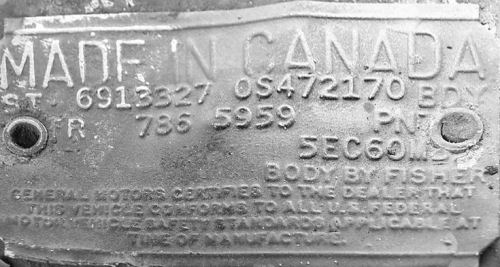
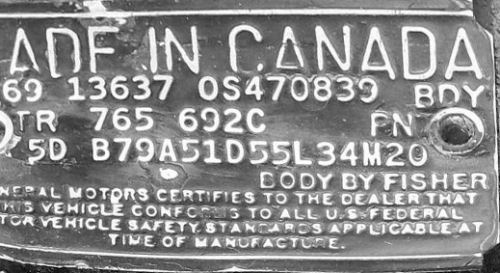
The second information line contains the abbreviation TR (for Trim) followed by a 3-digit number indicating the seat type (bucket or bench), color and material. Next is a pair of 2-digit numbers indicating the exterior paint color with the lower body color represented by the first pair and the upper body color represented by the second pair, and finally the word PNT. When the second pair is replaced by a number/letter combination, this combination indicates a vinyl or convertible top color. In this example, 692C, means the car has a vinyl top as noted by the "2C" where "2" is a vinyl top ("1" is a convertible top) and "C" is a dark blue vinyl top.
The third information line only contains the body assembly date consisting of the month as a 1- or 2-digit number and a single letter (A…E) designating the week. When the month is a single digit month (January through September) the month number is not padded with a leading zero (0) such as 01, 02, 03, etc. In this example 5D is the 5th month (May) and “D” represents the 4th week.
Next are various RPO codes that are applicable to the car. Since the SS396 became an option in 1969, it's easy to spot a Canada-built SS396 by the L34 396/350hp engine code on the trim tag.

 Home
Home Decode
Decode Tech
Tech Tools
Tools Dale's Coins/CDs
Dale's Coins/CDs Contact
Contact Chevelle
of the Month
Chevelle
of the Month Things
For Sale
Things
For Sale Custom
Stickers
Custom
Stickers